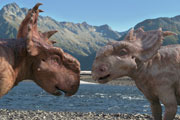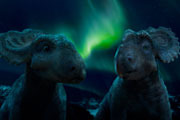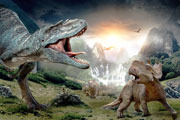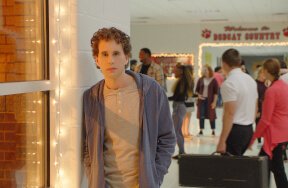Paleontologist Stephen Brusatte (that's a real-life dinosaur expert) helped make the movie magic happen in Walking With Dinosaurs by making sure every dino-detail was true to science - we had the chance to catch up with Stephen and find out what it was like creating these prehistoric creatures from scratch and bringing them to the big screen, as well as working as the on-set scientist. Find out more about what Stephen had to say in his Kidzworld interview.
Kidzworld: How long have you been a scientific consultant for movies and TV?
- Stephen: I began consulting with the Walking With Dinosaurs team in the summer of 2012, but I have consulted for other television programs and books for about 10 years. WWD was the first film I consulted on!
 Paleontologist Stephen Brusatte
Paleontologist Stephen Brusatte
Kidzworld: We understand that for Walking With Dinosaurs 3D, a lot of work was put in to make sure the dinosaurs were as realistic as possible (thanks to you!) – can you describe what that entailed?
- Stephen: Yes--I think that Walking With Dinosaurs 3D is the most realistic portrayal of dinosaurs that has ever been done on the silver screen, or on any screen for that matter. This is a testament to the filmmakers and directors, who really wanted to be sure that the dinosaurs were accurate and not cartoonish stereotypes or monsters. About 10 paleontologists consulted with the filmmakers to ensure that the dinosaurs were realistic. So this meant making sure that the size, the posture, and the movement of the dinosaurs were in line with what we know from fossil evidence. The CGI models for all of the dinosaurs were checked carefully by individual paleontologists who are world experts on those particular types of dinosaur.
Kidzworld: Were you always interested in dinosaurs? Which one fascinates you the most and why?
- Stephen: Surprisingly, no. I wasn't one of those five-year-olds who knows all of the dinosaurs and can put their parents to shame by pronouncing all of the names. I meet young dinosaur fanatics often, because I visit a lot of schools to talk about dinosaurs and science. And they always amaze me with their knowledge. And I always tell them that they are way ahead of where I was at their age. I didn't much care about science as a kid. I more enjoyed reading about history and travel, and watching baseball games. I only became enthused with science when I started high school, so when I was about 14-15 years old. And then it just took off. The spark was lit. Today, I am mostly fascinated by the carnivorous dinosaurs--Tyrannosaurus, Velociraptor, those types of dinosaurs. They are my research specialty.
 Playful Pachyrhinosaurus PatchiCourtesy of Twentieth Century Fox
Playful Pachyrhinosaurus PatchiCourtesy of Twentieth Century Fox
Kidzworld: What’s the first on-screen portrayal of dinosaurs that you remember, and what was your reaction to it?
- Stephen: Jurassic Park. It came out when I was nine-years-old. I didn't really care about dinosaurs or science at the time, but I remember seeing the film in the cinema and being awed by it. The special effects were unlike anything I had ever seen. The dinosaurs terrified me. But I loved the film. And my brothers loved it to, especially my youngest brother Chris, who was the real dinosaur expert in our family!
Kidzworld: Animation has advanced greatly in the last few years with CG technology, do you think the dinosaurs in WWD are the most accurate to date?
- Stephen: Absolutely. They are the most realistic and accurate dinosaurs that have ever been reconstructed using CGI, by a long mile.
Kidzworld: Despite knowing more than we did in past years, there must still be some things that are guess-work for how dinosaurs looked, moved or acted – are there any parts of the film where you had to make a judgment call without knowing for sure?
- Stephen: Of course. The fossil record will never be perfect. Even if we have complete skeletons, there are a lot of things about dinosaurs that we'll never know, because we can't watch them move and feed and reproduce and grow. We don't know for certain what colors most dinosaurs were, so that is largely guesswork based on comparisons with living relatives of dinosaurs, which give some indication of possible colors. We also don't know exactly how dinosaurs would have interacted with each other. We do know that some dinosaurs formed huge herds, like the Pachyrhinosaurus dinosaurs in the film. We know this because we find hundreds or sometimes thousands of their skeletons together at the same fossil sites, in huge 'bone beds.' But we don't know how the herds behaved. How dinosaurs courted each other. How the parents interacted with their children. How the herds were led.
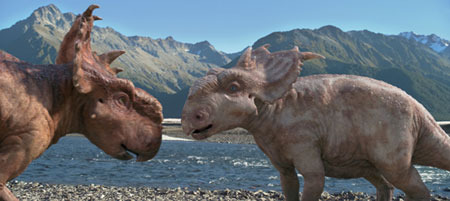 Courtesy of Twentieth Century Fox
Courtesy of Twentieth Century Fox
Kidzworld: Paleontologists study the remains of dinosaurs for clues, what was it like seeing them brought to life like this for you?
- Stephen: It sounds very lame, but I have to admit that a tear came to my eye when I first saw the Gorgosaurus--the big predator--in the Walking With Dinosaurs film. These are the dinosaurs that I study. I have spent years learning about them, pouring over their skeletons at museums all over the world, going out in the field and digging up new ones. But all I have are bones. Seeing this dinosaur brought to life on the big screen was like seeing a child grow up! I really wish I could observe these dinosaurs in the wild, but that is obviously impossible, so the WWD film is the next best thing!
Kidzworld: What did you enjoy most about working on WWD?
- Stephen: I love communicating science to the public. People love dinosaurs, especially kids. It's awesome to see people light up when they see a dinosaur skeleton in a museum, or a dinosaur come to life on the screen. Dinosaurs give us a rare opportunity to communicate science to the general public, so I enjoy taking those opportunities. And I loved working with the filmmakers and the production team behind WWD. They are incredibly smart, creative, artistic people. They're the best in their business and at the top of their field. I always love working with interesting people. It was a neat opportunity to learn more about how films are made.
Kidzworld: What do you think has been the coolest part of your job as a paleontologist so far?
- Stephen: I get to travel around the world to hunt for dinosaurs. How cool is that? I am incredibly fortunate. I've been able to travel around four continents and meet new colleagues from across the globe. I have been able to travel out into many field sites and find dinosaur bones that are tens of millions of years old, that have never been seen by human eyes before. It is just incredible to think about it.
Kidzworld: What do you hope audiences will take away from the film?
- Stephen: I hope this film will help inspire a new generation of dinosaur enthusiasts. I hope it will show the public, especially kids, a lot of the amazing new things that we've learned about dinosaurs over the past decade. We know so much more than we did 20 years ago when Jurassic Park came out. For example, we now know that most dinosaurs were covered in feathers! Just like birds! You didn't see any feathered dinosaurs in Jurassic Park because that information wasn't known 20 years ago. The field is moving so fast, we are discovering so much every day. A new species of dinosaur is found somewhere around the world once a week! Science is a continual process of discovery, and I hope the film helps show kids why science is so awesome.
Kidzworld: Do you have plans to work on another movie like this? A sequel for instance...?
- Stephen: I would love to! I don't know what is in the future for the "Walking With Dinosaurs" program, but I look forward to whatever the future brings! Hopefully that means more television programs, films, online films and other digital content, apps, etc. There are so many tools now to bring information to the public and we need to use these tools to show people, especially kids, just how awesome dinosaurs really were...and to articulate the broader message about how dinosaurs are important for telling us about how the earth has changed over time, how animals have responded to changing climates and environments, and how evolution happens.
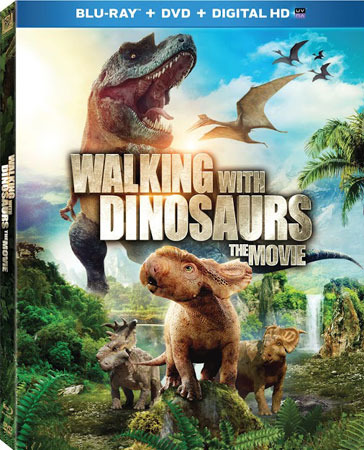 Walking With Dinosaurs Blu-rayCourtesy of Twentieth Century Fox
Walking With Dinosaurs Blu-rayCourtesy of Twentieth Century Fox
Walking With Dinosaurs is now available on Blu-ray + DVD!




























